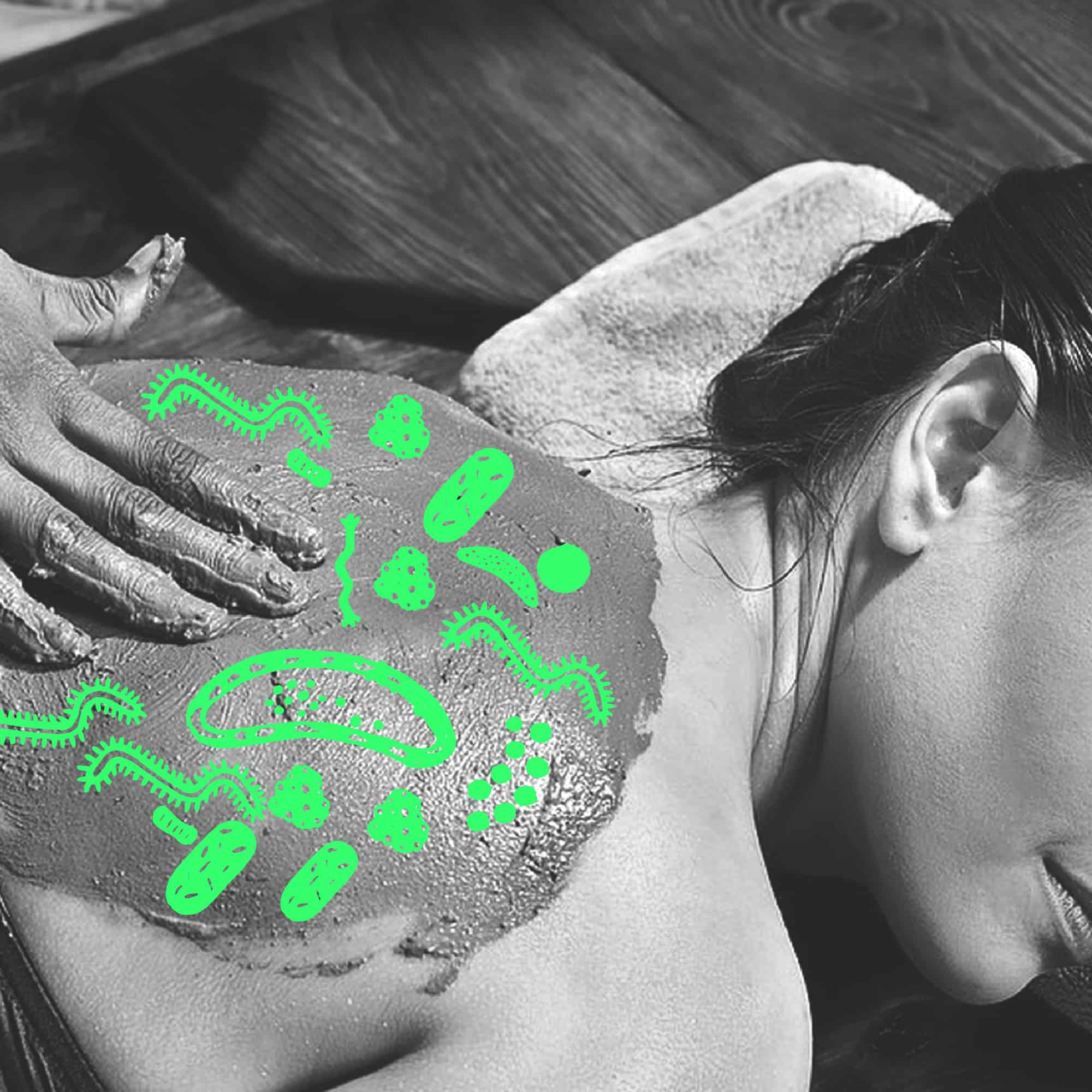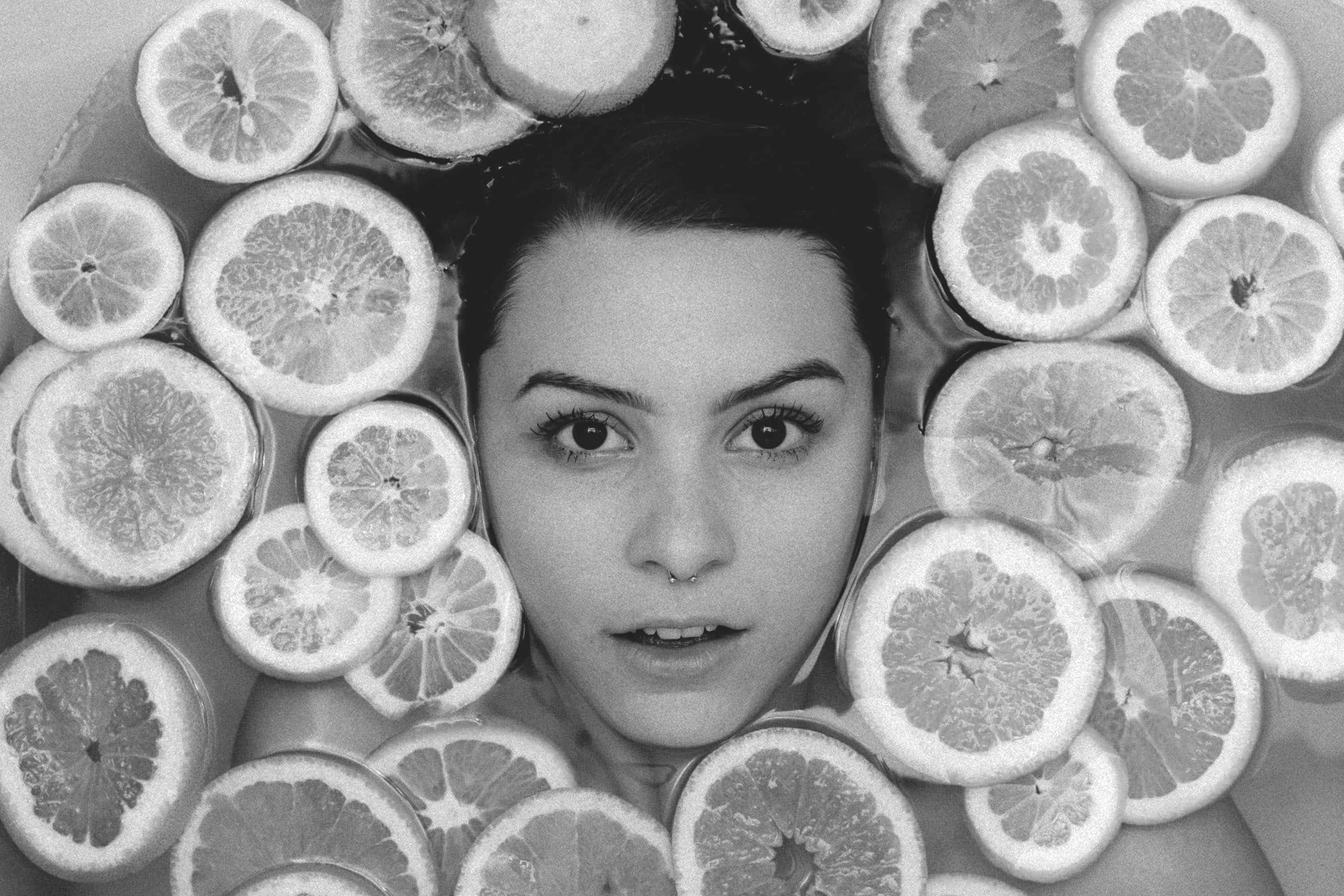Mature microbiome communities reject interlopers.
One of the reasons underpinning why our skin microbiome is such an effective invisible shield, and such a formidable challenge to formulators wishing to introduce microbes (via probiotic products), is its rejection of interlopers. As discussed in blogs on The Secret Life of Skin, the skin microbiome is a dynamic interdependent community, which is hostile to microbes from the environment and prevents them from easily becoming established. But what happens to this living defence system when the skin’s microbiome suffers a catastrophic event such as long immersion in hot or cold spring waters? Or even the salty sea water – particularly the renowned Dead sea, or into luxurious muds of various types such as those associated with spa treatments? Could these treatments be inflicting enough damage to the skin’s microbiome that the reported benefits are due to the microbiome ‘’re-booting’’ as it recovers? A skin microbiome, weakened by spa treatments, may be less hostile to indigenous microbes living in these waters and muds. So, do the otherwise alien microbes have a window of opportunity to become established and, in their struggle, trigger beneficial effects?
Unquestioning popularity of spa treatments
Extreme bathing, along with seaweed wraps and mud treatments, have been practiced in one form or another, throughout the world, since prehistoric times. Whether forming part of ritual purification to bring about various cures or for cleansing and recreation, humans have gone to great lengths, often travelling long distances, to seek out these treatments (Nathaniel Altman 2000). There are many examples of towns with rivers, springs and watering holes famed for their mystical powers. The Roman town Aquae Spadanae, known today as, Spa in eastern Belgium’s Ardennes region, is one such town and claims to be the origin of the word Spa. Unsurprisingly, this area is known for its mineral-rich thermal waters (Virendra Ligade 2011) and the decorative, water-tight wooden boxes in their Musée de la Ville d’Eaux, which bears witness to our historic reverence to spa treatments (The Museum of the City of Water 2014).
Although a strong belief and popularity of a practice does not necessarily indicate genuine efficacy, when combined with such a long continuous history, they do justify serious scientific explanation. With the popularity for spas continuing to grow, it is important to understand how and why they are effective. Today the popularity is unquestionable: the current global forecasts have spa treatments rising at 5.66% CAGR from 2017 to 2021 (First Research, Inc. 2019). Globally, spas are generating approximately $99 billion in revenue (TechNavio 2018), and countries such as India see themselves investing in the spa industry, with the aim of becoming premier spa destinations.
Science behind spa treatments
From a scientific point of view, despite centuries of study, at best we can only partly explain how the different spa waters and mud treatments may work. At the cellular level, there is mounting evidence, from in vitro studies, that spa waters affect cell metabolism and the inflammatory cascade. In a recent study, human lung fibroblasts cell cultures, treated with mineral waters from three Spanish health resorts, showed a significant increase in cell proliferation together with an enhanced antioxidant capacity. The researchers saw an increase in reactive oxygen and nitrogen species, glutathione levels and superoxide dismutase activity in the mineral water-treated fibroblasts and an increase in the release of cytokines, MIF, IL-6, CL-1, CCL-5 and ICAM-1, which are involved in wound healing and cell migration (Martínez-Galá 2019). Interestingly, other scientists have shown that factors in spa waters, which are normally considered toxic, such as hydrogen sulfide, play a part in modulating inflammation and healing (Sergio Davinelli 2019).

The perceived wisdom for centuries has been that spa benefits are due to the unique properties of the spa waters and in particular, to the dissolved minerals. In recent times, benefits have been attributed to combinations of several things such as the psychological effects of taking time to relax, the mineral salts, inhaling volatiles and the effects of high or low temperatures. Certainly, research by sports scientists, show that taking long hot baths, with temperatures equivalent to hot springs, improve metabolic health and boost anti-inflammatory responses (The Conversation 2017). Yet, since immersion in man-made mineral solutions at different temperatures has not proved to be as effective as bathing in natural spa waters, we may have missed a key factor responsible for the benefits of spa treatments.
So, what is the secret? The authors of an article recently published in the International Journal of Biometeorology, discussing the chemical effects of the different spa water disinfection treatments, argue that all the while the sources of spa health benefits remain unclear, they may well be due to the organic fraction in spa waters and to the interactions taking place among the many aquatic microorganisms (Varga 2019). Double-blind studies, demonstrating the health effects of pure organic fraction from the thermal/mineral water found in Szigetvár, South Carpathian Basin (Hanzel A 2019), adds weight to their reasoning that letting the spa water microbiome control any potentially disease-causing microorganisms living harmlessly (Sevillano D 2018), may be generally preferable to disinfection. In other words, the naturally-regulating balance in the organic substances – like water – maybe the secret to the spa’s benefits.
Exchanging microbes between microbiomes
Recent research shows that skin microbiome, weakened by swimming in the sea, can exchange microbes with those in sea water. Following swimming, the genus vibrio fraction living in the skin microbiome was found to be greater than 10 times the fraction in the ocean water. (Nielsen 2019).
Further evidence of human lifestyles facilitating microbes moving between microbiomes comes from the comprehensive study of mammals’ skin microbiomes, which revealed the uniqueness of human-associated microbial communities among Mammalia. The authors conclude that ”given the recent evolutionary divergence of humans as distinct species from other non-human primates, their results suggest that modern human practices, such as living within a built environment, wearing clothing, and washing with soap, have strongly impacted the diversity and composition of the skin microbiota” (Ross 2018). This summer saw the publication of the landmark study by scientists at Amway and Microbiome, in the scientific journal mBio. They found that up to 20% of the variability of the bacteria on people’s skin can be explained by demographic, physiologic and lifestyle factors (Pedro A. Dimitriu 2019).
Could disrupting rebooting’’ skin microbiome be a means for good?
All the while the sources of spa health benefits remain unclear. There is an abundance of different mineral waters, sea waters, muds and clays, each with unique properties in terms of pH, mineral composition, ion exchange capacities, organic content, microbiomes etc., all claiming similar health benefits in spa treatments. The idea that they are all function through disrupting the skin’s microbiome, or the one effect they all have in common, becomes very attractive.
A review of the effect of muds used for treating rheumatic and dermatological conditions, on skin microbiome certainly suggest that these muds, through their various properties, do disrupt the skin microbiome. The authors suggest that benefits of these muds could be brought about indirectly through the skin microbiome, which is known to modulate immune function and inflammatory response (Antonelli 2018). Another study looking for changes in the skin microbiomes of patients suffering atopic dermatitis following Dead Sea climatotherapy, showed significant but temporary changes in their skin’s microbiome in terms of balance and diversity (Meshner 2019).
Obviously, far more research is needed before a role for skin microbiome in the efficacy of spa treatments is determined but, in the meantime, formulators eveloping products for established skin microbiomes might try emulating IT engineers and start by ‘’rebooting’’ with a spa treatment. Until then, it seems a self-indulgent spa treatment certainly won’t harm…
Want to read more? Look at our content hub here and our Instagram here.

References
- Antonelli, M. & Donelli, D. 2018. “Mud therapy and skin microbiome: a review.” Int J Biometeorol 62: 2037. https://doi.org/10.1007/s00484-018-1599-y.
- First Research, Inc. . 2019. “Spa Services.” MarketResearch.com. May. Accessed October 8, 2019. https://www.marketresearch.com/First-Research-Inc-v3470/Spa-Services-12414460/#.XZxVv96ynek.email.
- Hanzel A, Berényi K, Horváth K, Szendi K, Németh B, Varga C. 2019. “Evidence for the therapeutic effect of the organic content in Szigetvár thermal water on osteoarthritis: a double-blind, randomized, controlled clinical trial.” Int J Biometeorol. https://doi.org/10.1007/s00484-019-01676-3.
- Martínez-Galá, Laura María Melgar-SánchezInmaculada García-RuizVirginia Pardo-MarquésMaría Teresa Agulló-OrtuñoInés. 2019. “Influence of mineral waters on in vitro proliferation, antioxidant response and cytokine production in a human lung fibroblasts cell line.” International Journal of Biometeorology Volume 63, Issue 9, 1171–1180.
- Meshner, Michael Brandwein Garold Fuks Avigail Israel Fareed Sabbah Emmilia Hodak Amir Szitenberg Marco Harari Droron Steinberg Zvi Bentwich Noam Shental Shiri. 2019. “Skin Microbiome Compositional Changes in Atopic Dermatitis Accompany Dead Sea Climatotherapy.” Phytochemistry and Phytobiology https://doi.org/10.1111/php.13119.
- Nathaniel Altman. 2000. Healing springs: the ultimate guide to taking the waters : from hidden springs to the world’s greatest spas. Inner Traditions:. Healing Arts Press. ISBN 0-89281-836-0.
- Nielsen, M. C., and Jiang, S. 2019. “Alterations of the human skin microbiome after ocean water exposure.” Marine Pollution Bulletin 145: 595-603.
- Pedro A. Dimitriu, Brandon Iker, Kausar Malik, Hilary Leung, W. W. Mohn, Greg G. Hillebrand. 2019. “New Insights into the Intrinsic and Extrinsic Factors That Shape the Human Skin Microbiome.” mBio Vol 10 Issue 4 – Am Soc Microbiol 1-12.
- Ross, A. A., Müller, K. M., Weese, J. S., and Neufeld,, J. D. 2018. “Comprehensive skin microbiome analysis reveals the uniqueness of human skin and evidence for phylosymbiosis within the class Mammalia.” PNAS 115 (25): E5785-E5795.
- Sergio Davinelli, Franco Bassetto, Marco Vitale, Giovanni Scapagnini. 2019. “Thermal Waters and the Hormetic Effects of Hydrogen Sulfide on Inflammatory Arthritis and Wound Healing.” In The Science of Hormesis in Health and Longevity, by Suresh I.S. Rattan and Marios Kyriazis, Ch 10. 121-126. Academic Press.
- Sevillano D, Romero-Lasta CI, Alou L, Gonzáles N, Collado L,Domunguez AA, Arias CM, Corvillo I, Armijo F, Romero M, Maraver F. 2018. “Impact of the biotic and abiotic components of low mineralized natural mineral waters on the growth of pathogenic bacteria of human origin: a key to self-control of spa water quality.” J Hydrol 566:227–234.
- TechNavio . 2018. “Global Spa Market 2019-2023.” Nov. Accessed October 8, 2019. https://www.marketresearch.com/Infiniti-Research-Limited-v2680/Global-Spa-12050752/.
- The Conversation. 2017. A hot bath has benefits similar to exercis. 20 March. Accessed October 8, 2019. https://theconversation.com/a-hot-bath-has-benefits-similar-to-exercise-74600.
- The Museum of the City of Water. 2014. “Spa Story, a story that flows naturally …” 15 November. Accessed October 8, 2019. http://www.spavillaroyale.be/.
- Varga, C. 2019. “To treat or not to treat? Misbeliefs in spa water disinfection.” Int J Biometeorol 1135. https://doi.org/10.1007/s00484-019-01722-0.
- Virendra Ligade, D. Sreedhar, Manthan J, Ajay Pise, N. Udupa. 2011. “SPA IN INDIA: AN ALTERNATIVE THERAPY.” IJCRR, Vol 03 issue 11 202-205.

